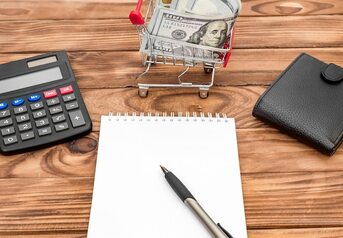Keys to anticipate expenses in your home purchases

Anticipating expenses in your household purchases can be the key to maintaining a balanced budget and avoiding unpleasant surprises. In this article, we will provide you with a practical and effective checklist that will help you plan each purchase, from furniture to cleaning supplies. You will learn to identify hidden costs and make informed decisions that fit your needs and lifestyle. Get ready to become a smart shopper!
1. Set a clear monthly budget.
Establishing a clear monthly budget is the first fundamental step to anticipate expenses in your home purchases. A well-defined budget will give you a clear view of your income and expenses, helping you identify how much you can spend in each category related to your home, whether it's on furniture, appliances, or cleaning supplies. To do this, it's advisable to make a detailed list of all the fixed and variable expenses you have each month. This exercise will not only help you avoid excess spending but will also allow you to save for important future purchases.
Once you have a clear budget, it is essential to review it regularly and adjust it as needed. Priorities can change, and unexpected expenses may arise; therefore, maintaining flexibility within your financial planning will allow you to adapt without falling into economic imbalances. By setting a specific limit for your household purchases, you will be able to manage your finances better and make more informed decisions about which products to acquire. With a disciplined approach, you will be able to enjoy a pleasant home environment without compromising your financial stability.
2. Research prices before leaving home
Researching prices before leaving home is a fundamental strategy to anticipate expenses and maximize your budget. With the wide range of options available in the market, from physical stores to online platforms, taking the time to compare prices will give you a clear idea of what you really need to spend. Use apps and websites that offer price comparisons and product reviews, which will not only help you find the best deals but also identify the quality of the item you plan to purchase. Remember to note down the most relevant prices and features to facilitate your final decision.
Additionally, researching in advance allows you to detect possible promotions or special discounts that may be in effect. Many stores offer sales on certain days or during specific events, so being aware of these opportunities can mean significant savings. It is also advisable to consider additional costs that may arise after the purchase, such as shipping or installation, to avoid unpleasant surprises. By planning your purchases with this information in hand, you can make smarter decisions aligned with your financial goals.
3. Create a prioritized shopping list.
One of the most effective strategies for anticipating expenses in your household purchases is to create a prioritized shopping list. This approach allows you to identify which items are truly necessary and which can wait, helping you focus on the essentials. When creating your list, consider categorizing the items into "needs," "wants," and "upgrades." This way, you can allocate a specific budget to each category and avoid impulsive spending on non-urgent items.
It is also advisable to regularly review your list to adjust it as your needs or circumstances change. For example, if you have decided to redecorate a room or if certain appliances need to be replaced, you can reevaluate which items should take priority. Don't forget to include in your list research on prices and purchasing options; this will allow you to compare alternatives and make informed decisions that align with your overall budget. With a well-crafted prioritized list, you will be better prepared to face household expenses without compromising your personal finances.
4. Consider the long-term maintenance costs.
When planning your home purchases, it is crucial to not only consider the initial price of the products but also the maintenance costs that may arise over time. For example, when acquiring an appliance, consider energy efficiency and the cost of potential repairs. Some items may seem like a good deal due to their low price, but if they require frequent repairs or consume more electricity, you could end up spending much more in the long run. Research the durability and reliability of the products before making a decision.
It is also advisable to evaluate all expenses associated with the maintenance of your home. This includes not only the items you purchase but also services like professional cleaning or regular maintenance. When creating a realistic budget, be sure to include these recurring costs that might be overlooked at first. This way, you will be better able to anticipate your future expenses and make informed decisions that not only fit your immediate budget but are also sustainable over time.
5. Take advantage of offers and discounts strategically.
Leveraging offers and discounts strategically is a skill that can make a difference in your household budget. Before making any purchase, be sure to research and compare prices at different stores, both physical and online. Often, retailers launch special promotions on specific dates or during seasonal changes. By staying alert to these opportunities, you can not only obtain products at a lower price but also have the chance to acquire higher-quality items that you might not have considered if you were constrained by a tight budget.
It is also beneficial to subscribe to newsletters and follow your favorite brands on social media to receive alerts about exclusive sales and additional discounts. Don't forget to use apps and websites that collect coupons or notify you when there are sales on products you have been considering. However, be careful: the key is to only buy what you really need and avoid getting carried away by tempting offers that could lead you to spend more than planned. With a mindful approach to shopping, you can maximize your savings and keep your home well-equipped without compromising your financial balance.
6. Evaluate if you really need the article.
Before making a purchase, it is essential to assess whether you truly need the item in question. Often, we are carried away by impulses or current trends, which can lead to unnecessary acquisitions and budget overflow. Take a moment to reflect on the functionality of the product: Does it really improve your quality of life? Is it a replacement for something you already have? Asking yourself these questions can help you distinguish between a genuine need and a fleeting desire.
Another effective strategy is to consider the long-term use you will give to the item. Ask yourself if it will integrate well with your daily habits and routines. For example, if you are thinking about buying a new appliance, make sure that it will actually be used regularly and won't end up stored in a corner. Evaluating the durability and actual utility of the product will allow you to make more informed choices and avoid unnecessary expenses that could affect your household budget. Ultimately, the key is to prioritize your real needs over temporary desires to maintain financial control in your home.
7. Add a margin for contingencies in your budget.
When planning your household shopping expenses, it's essential to include a margin for unexpected costs in your budget. Even if you have researched and estimated the costs of each item, there is always the possibility that additional unexpected expenses may arise. For example, when purchasing furniture, you might find that you also need to buy complementary items like cushions or protectors. These small details can add up quickly if you haven't accounted for a margin in your planning.
A good approach is to allocate between 10% and 15% of your total budget to this contingency fund. This way, you ensure that you are prepared for any additional costs that may arise during the purchasing or installation process. This margin will not only provide you with peace of mind, but it will also allow you to act flexibly in the face of unexpected opportunities or needs without compromising your personal finances. Ultimately, anticipating the unexpected translates into a more satisfying and less stressful shopping experience.
8. Compare different stores and online platforms.
When shopping for the home, it's essential to compare different stores and online platforms before making a final decision. Each establishment may offer varying prices and promotions, so spending time researching can result in significant savings. In addition to prices, it's important to consider shipping costs and return policies, as these can affect the total price of your purchase. Using online comparison tools or apps that facilitate this task will allow you to quickly see the best available deals.
You should not only focus on prices but also on product quality and reviews from other buyers. Often, a cheaper item may seem like a good option initially, but if it does not meet your expectations or deteriorates quickly, you will end up spending more in the long run. Therefore, make sure to read opinions and assess the reputation of each store before making your purchase. By doing this, you will not only be taking care of your budget but also investing wisely in products that truly add value to your home.
9. Track your monthly expenses.
Tracking your monthly expenses is a fundamental practice for maintaining control over your household budget. By recording every purchase, from larger items to those small but frequent ones, you can get a clear view of where your money is going. There are various tools you can use to facilitate this process, such as personal finance apps or simple spreadsheets. The key is to be consistent and honest with yourself when documenting each expense, which will allow you to identify patterns and areas where you could cut back.
In addition, keeping a detailed record will help you anticipate future expenses and plan more effectively for the necessary purchases for your home. Over time, you will be able to compare your monthly expenses and adjust your budget according to the trends you observe. For example, if you notice that you are spending more on cleaning products in certain months, you might consider buying in larger quantities during promotions or looking for more economical alternatives. This tracking not only encourages financial responsibility but also gives you the peace of mind of knowing that you are making informed decisions that fit your financial capabilities.



